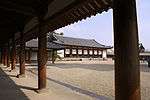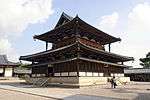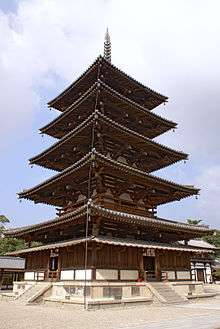List of Important Cultural Properties of Japan (Asuka period: structures)
This list is of Japanese structures dating from the Asuka period (538–710) that have been designated Important Cultural Properties (including *National Treasures).[1] Five surviving sites with six component structures have been so designated, all National Treasures.[2] All are located in the town of Ikaruga in Nara Prefecture, forming part of the UNESCO World Heritage Site Buddhist Monuments in the Hōryū-ji Area.[3]
Structures
| Structure | Date | Municipality | Prefecture | Comments | Image | Coordinates | Ref. |
|---|---|---|---|---|---|---|---|
| *Hokki-ji Three-Storey Pagoda 法起寺三重塔 Hokkiji sanjūnotō | 684-706 | Ikaruga | Nara |  | 34°37′22″N 135°44′47″E / 34.62282547°N 135.74632744°E | ||
| *Hōryū-ji Covered Corridors: East 法隆寺廻廊 (東廻廊) Hōryūji kairō (higashi kairō) | before 709 | Ikaruga | Nara |  | 34°36′52″N 135°44′05″E / 34.61435107°N 135.73474349°E | ||
| *Hōryū-ji Covered Corridors: West 法隆寺廻廊 (西廻廊) Hōryūji kairō (nishi kairō) | before 709 | Ikaruga | Nara |  | 34°36′51″N 135°44′02″E / 34.614191°N 135.733826°E | ||
| *Hōryū-ji Kondō 法隆寺金堂 Hōryūji kondō | before 709 | Ikaruga | Nara |  | 34°36′51″N 135°44′04″E / 34.6142695°N 135.7344433°E | ||
| *Hōryū-ji Five-Storey Pagoda 法隆寺五重塔 Hōryūji gojūnotō | before 709 | Ikaruga | Nara |  | 34°36′51″N 135°44′03″E / 34.61423034°N 135.73410721°E | ||
| *Hōryū-ji Inner Gate 法隆寺中門 Hōryūji chūmon | before 709 | Ikaruga | Nara |  | 34°36′50″N 135°44′04″E / 34.61396278°N 135.73430952°E |
See also
| Wikimedia Commons has media related to Architecture of Asuka period. |
References
- ↑ "Preservation and Utilization of Cultural Properties" (PDF). Agency for Cultural Affairs. Archived from the original (PDF) on 26 September 2013. Retrieved 26 August 2013.
- ↑ "Database of National Cultural Properties: 国宝・重要文化財 (建造物): 飛鳥" (in Japanese). Agency for Cultural Affairs. Retrieved 26 August 2013.
- ↑ "Buddhist Monuments in the Horyu-ji Area". UNESCO. Retrieved 26 August 2013.
This article is issued from
Wikipedia.
The text is licensed under Creative Commons - Attribution - Sharealike.
Additional terms may apply for the media files.